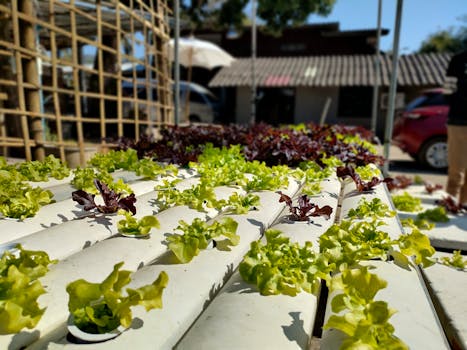Anúncios
Building agricultural resources is essential for sustainable farming practices. It not only enhances productivity but also supports environmental health. Modern agriculture must adapt to changing needs while preserving natural ecosystems.
Investment in agricultural resources strengthens food systems. Efficient use of land, water, and technology fosters resilience against climatic changes. Farmers today rely on innovative methods to boost yields sustainably.
In this article, we will explore various aspects of building agricultural resources. From soil health to modern technology, understanding these elements is crucial for anyone involved in agriculture.
Understanding Soil Health
Soil health is the cornerstone of successful agriculture. Healthy soil means better crop yields and overall farm productivity. Implementing practices that nurture soil is essential for sustainable agriculture.
Soil structure, nutrient content, and microbial diversity need attention. Regular soil testing helps farmers identify deficiencies and make informed decisions. This, in turn, optimizes fertilization and crop rotation strategies.
Anúncios
Cover crops can significantly improve soil health. They prevent erosion, enhance nutrient cycling, and suppress weeds. Selecting appropriate cover crops fosters an environment where beneficial organisms thrive.
Organic matter plays a vital role in soil health. Compost and mulch increase organic content, thus improving moisture retention. As a result, plants receive adequate nutrition, leading to healthier growth.
Investing in soil conservation technologies can further enhance health. Reduced tillage, terracing, and contour farming are just a few examples. These methods ensure sustainable land use and minimize degradation.
Anúncios
Water Management Techniques
Water management is crucial for agricultural sustainability. Efficient irrigation systems prevent waste and ensure crops receive sufficient moisture. Understanding water resources helps make better farming decisions.
Implementing drip irrigation systems can save significant amounts of water. This targeted approach delivers water directly to the plant roots, reducing evaporation and runoff. Thus, it boosts crop performance without overusing resources.
Rainwater harvesting is another strategy that farmers can adopt. Collecting rainwater conserves groundwater and reduces reliance on municipal supplies. It provides an alternative source for irrigation during dry spells.
Crop selection must take water availability into account. Choosing drought-resistant varieties can ensure productivity in water-scarce regions. These adaptations are vital for long-term agricultural resilience.
Monitoring soil moisture levels enhances water management. Utilizing soil moisture sensors can provide real-time information, allowing farmers to decide when and how much to irrigate. This ensures optimal water usage.
Utilizing Sustainable Practices
Sustainable agriculture balances production and environmental health. Techniques like crop rotation and agroforestry promote ecosystem diversity and productivity. Adopting these practices benefits both farmers and the planet.
Integrated Pest Management (IPM) is an effective sustainable practice. This approach combines biological, cultural, and chemical methods to manage pests, reducing reliance on harmful pesticides. Healthier ecosystems result from fewer chemicals in the environment.
Organic farming is another avenue for sustainable agriculture. It emphasizes the use of natural inputs and processes. Organic farmers focus on maintaining soil fertility and biodiversity, which enhance productivity long-term.
Permaculture is gaining popularity as a sustainable farming method. It designs agricultural landscapes that mimic natural ecosystems. By incorporating various plants, farmers enhance resilience and maximize resource efficiency.
Educating farmers about sustainable practices is essential. Workshops and community programs can increase awareness and adoption. Shared knowledge supports the development of regional sustainable agriculture networks.
Embracing Technology and Innovation
Technology plays a pivotal role in modern agriculture. Advancements in tools and techniques enhance productivity and resource management. Embracing innovation can benefit all sectors of farming.
Precision agriculture utilizes data and technology to optimize farm operations. GPS, drones, and sensors enable farmers to make data-driven decisions. This targeted approach minimizes waste and improves yields.
Using mobile applications can streamline farm management. Tools for tracking weather, soil conditions, and crop health empower farmers. These resources help in making informed choices throughout the growing season.
Robotics and automation are transforming agricultural practices. Automated tractors and harvesters increase efficiency and reduce labor costs. This wave of technology simplifies farm work and enhances productivity.
Investing in research and development is crucial for continued innovation. Collaborations between universities, governments, and industry leaders can push agricultural boundaries. This partnership fosters new solutions for emerging challenges.
Improving Crop Diversity
Crop diversity is vital for sustainable agriculture. A diverse range of crops enhances resilience against pests and diseases. This practice helps mitigate risks associated with monoculture systems.
Planting diverse crops can improve soil health and productivity. Different species interact beneficially, enhancing nutrient uptake and organic matter. These interactions contribute significantly to ecological balance on farms.
Incorporating native plant species fosters biodiversity. These species are adapted to local conditions and require fewer resources. They also attract beneficial insects and pollinators, promoting a healthy ecosystem.
Farmers should explore heirloom varietals and heritage crops. These older varieties often possess unique traits that can be advantageous. Furthermore, they add variety and resilience to the agricultural landscape.
Participatory breeding programs encourage farmer involvement. Engaging local farmers in developing improved crop varieties ensures that adaptations meet real-world needs. This collaborative process strengthens agricultural communities.
Building Strong Agricultural Communities
Strong agricultural communities are fundamental for resource sharing. Collaborative efforts lead to knowledge exchange and collective problem-solving. A united community fosters resilience and innovation in farming practices.
Local cooperatives support farmers by providing access to resources. From shared equipment to collective marketing, these groups empower members. Leveraging community support can significantly enhance farm profitability.
Training and education programs are vital for community development. Workshops, seminars, and mentorship initiatives build skills and knowledge among farmers. These resources help in adopting new technologies and practices effectively.
Networking events allow farmers to connect and share experiences. Building relationships fosters collaboration and resource sharing across agricultural sectors. A strong network can enhance resilience during challenging conditions.
Supporting local and regional food systems enhances communities. Direct marketing opportunities connect producers with consumers, strengthening the local economy. This approach promotes sustainably sourced food and fosters community bonds.
Conclusion
Building agricultural resources requires a multifaceted approach. By focusing on soil health, water management, sustainability, technology, crop diversity, and community strengthening, farmers can cultivate resilience.
Each component plays a crucial role in enhancing productivity and protecting the environment. Adapting to challenges necessitates ongoing learning, innovation, and collaboration among agricultural stakeholders.
As we strengthen agricultural resources, we promote a sustainable future for farming. Committing to these practices ensures we can nourish generations to come while respecting our planet.



